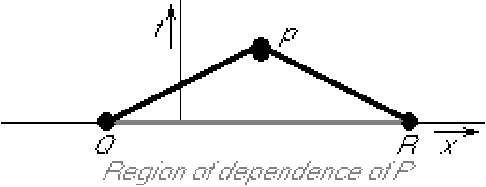|
|
|
|
|
Next: 4.2 Extension to finite regions |
|
The wave equation in two dimensions,
This solution was derived earlier. The functions ![]() and
and ![]() must
be found from whatever initial and boundary conditions are given. One
special case of that is the D'Alembert solution, which is the
subject of this brief chapter.
must
be found from whatever initial and boundary conditions are given. One
special case of that is the D'Alembert solution, which is the
subject of this brief chapter.
In its simplest form, the D'Alembert solution assumes that there are
no boundaries. That means that the ![]() -range is doubly infinite:
-range is doubly infinite:
Note that since the wave equation is second order in time, it needs two initial conditions. Physically, the wave equation might describe the vibrations of a string. The two initial conditions are then that both the initial position and the initial velocity of the string must be given at each point.
The two given initial conditions allow the unknown functions ![]() and
and
![]() in the solution of the wave equation to be determined. That
gives the solution directly in terms of the given functions
in the solution of the wave equation to be determined. That
gives the solution directly in terms of the given functions ![]() and
and
![]() :
:
 |
(4.1) |
The solution can be understood more physically from looking at the
![]() -plane:
-plane:


Note that the solution at point P depends on the initial conditions in the interval QR. In other words, the ``region of dependence'' of point P is the triangle QPR. Whatever is outside that triangle does not affect the solution at P at all.
Conversely, point P is inside the region of influence of all points inside the triangle. A change in the initial conditions at any initial point inside the triangle will influence the solution at P.